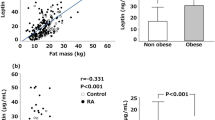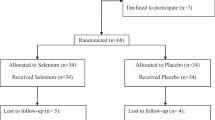Abstract
Rheumatoid arthritis (RA) is a chronic inflammatory disease in which numerous cells and mediators affect inflammatory conditions and disease severity. To compare the serum levels of adiponectin, vitamin D, copper, and zinc in patients with RA and to investigate the relationship between these parameters and RA severity. Ninety patients with RA and 30 healthy controls participated in this cross-sectional case-control study between November 2016 and April 2017; according to the ACR/EULAR criteria for RA. Serum levels of adiponectin were determined by ELISA; copper and zinc by colorimetric spectrophotometry; and vitamin D by HPLC. Kruskal-Wallis and Spearman tests were performed using SPSS software and data were depicted by GraphPad Prism software. Compared with healthy controls, the serum level of adiponectin was significantly increased, whereas vitamin D was significantly decreased in patients with RA. Adiponectin and vitamin D levels were inversely correlated in RA subgroups (P < 0.001, r = − 0.410). Adiponectin and vitamin D correlated with RA severity. Furthermore, no significant difference was found in copper and zinc levels between RA groups and controls. The definitive roles of adiponectin, vitamin D, copper, and zinc are not completely determined in RA development. Based on disease activity, these parameters can modulate inflammatory conditions, thus they have the potential to be used as promising therapeutic biomarkers to follow up the severity of disease, as well as the progression and treatment success in patients with RA.


Similar content being viewed by others
Abbreviations
- CRP:
-
C-reactive protein
- DAS28:
-
Disease activity score
- ESR:
-
Erythrocyte sedimentation rate
- ELISA:
-
Enzyme-linked immunosorbent assay
- HPLC:
-
High-performance liquid chromatography
- IL:
-
Interleukin
- MMP:
-
Matrix metalloproteinase
- NF-κB:
-
Nuclear factor-kappa B
- RA:
-
Rheumatoid arthritis
- SLE:
-
Systemic lupus erythematosus
- TNF:
-
Tumor necrosis factor
References
Kontny E, Plebanczyk M, Lisowska B, Olszewska M, Maldyk P, Maslinski W (2011) Comparison of rheumatoid articular adipose and synovial tissue reactivity to proinflammatory stimuli: contribution to adipocytokine network. Ann Rheum Dis 71:262–267
Uhlig T, Moe RH, Kvien TK (2014) The burden of disease in rheumatoid arthritis. Pharmacoeconomics 32:841–851
Coelho M, Oliveira T, Fernandes R (2013) Biochemistry of adipose tissue: an endocrine organ. Arch Med Sci 9:191
Ouchi N, Walsh K (2007) Adiponectin as an anti-inflammatory factor. Clin Chim Acta 380:24–30
Lee Y-A, Ji H-I, Lee S-H, Hong S-J, Yang H-I, Yoo MC et al (2014) The role of adiponectin in the production of IL-6, IL-8, VEGF and MMPs in human endothelial cells and osteoblasts: implications for arthritic joints. Exp Mol Med 46:e72
Meyer M, Sellam J, Fellahi S, Kotti S, Bastard J-P, Meyer O et al (2013) Serum level of adiponectin is a surrogate independent biomarker of radiographic disease progression in early rheumatoid arthritis: results from the ESPOIR cohort. Arthritis Res Ther 15:R210
Atherton K, Berry DJ, Parsons T, Macfarlane GJ, Power C, Hyppönen E (2009) Vitamin D and chronic widespread pain in a white middle-aged British population: evidence from a cross-sectional population survey. Ann Rheum Dis 68:817–822
Herly M, Stengaard-Pedersen K, Vestergaard P, Østergaard M, Junker P, Hetland ML et al (2018) The D-vitamin metabolite 1, 25 (OH) 2D in serum is associated with disease activity and Anti-Citrullinated Protein Antibodies in active and treatment naïve, early Rheumatoid Arthritis Patients. Scand J Immunol 88:e12704
He X-J, Ding Y, Xiang W, Dang X-Q (2016) Roles of 1, 25 (OH) 2D3 and vitamin D receptor in the pathogenesis of rheumatoid arthritis and systemic lupus erythematosus by regulating the activation of CD4 + T cells and the PKCδ/ERK signaling pathway. Cell Physiol Biochem 40:743–756
Turnlund JR, Jacob RA, Keen CL, Strain J, Kelley DS, Domek JM et al (2004) Long-term high copper intake: effects on indexes of copper status, antioxidant status, and immune function in young men. Am J Clin Nutr 79:1037–1044
Muñoz C, López M, Olivares M, Pizarro F, Arredondo M, Araya M (2005) Differential response of interleukin-2 production to chronic copper supplementation in healthy humans. Eur Cytokine Netw 16:261–265
Teles M, MacKenzie S, Boltana S, Callol A, Tort L (2011) “Gene expression and TNF-alpha secretion profile in rainbow trout macrophages following exposures to copper and bacterial lipopolysaccharide. Fish Shellfish Immunol 30:340–346
Yang T-H, Yuan T-H, Hwang Y-H, Lian I-B, Meng M, Su C-C (2015) Increased inflammation in rheumatoid arthritis patients living where farm soils contain high levels of copper. J Formosan Med Assoc 115:991–996
Overbeck S, Rink L, Haase H (2008) Modulating the immune response by oral zinc supplementation: a single approach for multiple diseases. Arch Immunol Ther Exp 56: 15–30,
Amancio OS, Chaud DA, Yanaguibashi G, Hilário ME (2003) Copper and zinc intake and serum levels in patients with juvenile rheumatoid arthritis. Eur J Clin Nutr 57:706–712
Soylak M, Kirnap M (2001) Serum copper and zinc concentrations of patients with rheumatoid arthritis from Kayseri-Turkey. Fresenius Environ Bull 10:409–410
Aletaha D, Neogi T, Silman AJ, Funovits J, Felson DT, Bingham CO et al (2010) 2010 rheumatoid arthritis classification criteria: an American College of Rheumatology/European League Against Rheumatism collaborative initiative. Arthritis Rheumatology 62:2569–2581
Anderson J, Caplan L, Yazdany J, Robbins ML, Neogi T, Michaud K et al (2012) Rheumatoid arthritis disease activity measures: american College of Rheumatology recommendations for use in clinical practice. Arthritis Care Res 64:640–647
Seif F, Khoshmirsafa M, Mousavi M, Beshkar P, Rafeian-Kopaei M, Bagheri N et al (2014) Interleukin-21 receptor might be a novel therapeutic target for the treatment of rheumatoid arthritis. J Exp Clin Med 6:57–61
Mohsenzadegan M, Fayazi MR, Abdolmaleki M, Bakhshayesh M, Seif F, Mousavizadeh K (2015) Direct immunomodulatory influence of IFN-β on human astrocytoma cells. Immunopharmacol Immunotoxicol 37:214–219
Seif F, Khoshmirsafa M, Aazami H, Mohsenzadegan M, Sedighi G, Bahar M (2017) The role of JAK-STAT signaling pathway and its regulators in the fate of T helper cells. Cell Commun Signal 15:23
Lee YH, Bae SC (2017) Circulating adiponectin and visfatin levels in rheumatoid arthritis and their correlation with disease activity: a meta-analysis. Int J Rheum Dis 21:664-672
Dini AA, Wang P, Ye D-Q (2017) Serum adiponectin levels in patients with systemic lupus erythematosus: a meta-analysis. J Clin Rheumatol 23:361–367
Shehzad W, Iqbal O, Shehzad, Lee YS (2012) Adiponectin: regulation of its production and its role in human diseases. Hormones (Athens) 11:8–20
Tang C-H, Chiu Y-C, Tan T-W, Yang R-S, Fu W-M (2007) Adiponectin enhances IL-6 production in human synovial fibroblast via an AdipoR1 receptor, AMPK, p38, and NF-κB pathway. J Immunol 179:5483–5492
Eidet JR, Fostad IG, Shields KJ, Lyberg T, Utheim TP, Kåss A et al (2015) A Low Adiponectin Level in Rheumatoid Arthritis Is Associated with Coronary Artery Disease. Arthritis Rheumatol 67:1982–1983
Neumann E, Junker S, Schett G, Frommer K, Müller-Ladner U (2016) Adipokines in bone disease. Nat Rev Rheumatol 12:296–302
Zhang Y, Leung DY, Richers BN, Liu Y, Remigio LK, Riches DW et al (2012) Vitamin D inhibits monocyte/macrophage proinflammatory cytokine production by targeting MAPK phosphatase-1. J Immunol 1102412
Sharma R, Saigal R, Goyal L, Mital P, Yadav R, Meena P et al (2014) “Estimation of vitamin D levels in rheumatoid arthritis patients and its correlation with the disease activity”. J Assoc Phys India 62:678–681
Ishikawa LLW, Colavite PM, de Campos Fraga-Silva TF, Mimura LAN, França TGD, Zorzella-Pezavento SFG et al (2017) Vitamin D deficiency and rheumatoid arthritis. Clin Rev Allergy Immunol 52:373–388
Song GG, Bae S-C, Lee YH (2012) Association between vitamin D intake and the risk of rheumatoid arthritis: a meta-analysis. Clin Rheumatol 31:1733–1739
Mateen S, Moin S, Shahzad S, Khan AQ (2017) Level of inflammatory cytokines in rheumatoid arthritis patients: Correlation with 25-hydroxy vitamin D and reactive oxygen species. PloS ONE 12:e0178879
Lin J, Liu J, Davies ML, Chen W (2016) Serum vitamin D level and rheumatoid arthritis disease activity: review and meta-analysis. PloS ONE 11:e0146351
Fakharan M, Haghighi A, Arabi M, Loghman M (2014) Investigating the levels of serum vitamin d in patients with rheumatoid arthritis referred to rasoul-akram hospital during 2011–2012. Iran J Med Sci 39:476
Shams E, Afshari M, Tajadini M, Keikha M, Qorbani R, Heshmat et al (2016) The relationship of serum vitamin D and Zinc in a nationally representative sample of Iranian children and adolescents: The CASPIAN-III study. Med J Islam Rep Iran 30:430
Heshmat R, Mohammad K, Majdzadeh S, Forouzanfar M, Bahrami A, Ranjbar Omrani G (2008) Vitamin D deficiency in Iran: a multi-center study among different urban areas Iran J Public Health
Hajjaj-Hassouni N, Mawani N, Allali F, Rkain H, Hassouni K, Hmamouchi I et al (2017) Evaluation of vitamin D status in rheumatoid arthritis and its association with disease activity across 15 countries:“The COMORA Study”. Int J Rheumatol. https://doi.org/10.1155/2017/5491676
Lee Y, Bae S-C (2016) “Vitamin D level in rheumatoid arthritis and its correlation with the disease activity: a meta-analysis”. Clin Exp Rheumatol 34:827–833
Das BK, Panda AK, “Vitamin D (2016) The unexplored immunomodulator. Int J Rheum Dis 19:332–334
Strecker A, Mierzecki, Radomska K (2013) Copper levels in patients with rheumatoid arthritis. Ann Agric Environ Med 20:312–316
Xin L, Yang X, Cai G, Fan D, Xia Q, Liu L et al (2015) Serum levels of copper and zinc in patients with rheumatoid arthritis: a meta-analysis. Biol Trace Elem Res 168:1–10
Zoli A, Altomonte L, Caricchio R, Galossi A, Mirone L, Ruffini M et al (1998) Serum zinc and copper in active rheumatoid arthritis: correlation with interleukin 1β and tumour necrosis factor α. Clinical Rheumatol 17:378–382
Tapiero H, Tew KD (2003) Trace elements in human physiology and pathology: zinc and metallothioneins. Biomed Pharmacother 57:399–411
Ala S, Shokrzadeh M, Pur SA, Saeedi SS (2009) Zinc and copper plasma concentrations in rheumatoid arthritis patients from a selected population in Iran. Pak J Biol Sci 12:1041–1044
Söderlin M, Petersson I, Geborek P (2012) The effect of smoking on response and drug survival in rheumatoid arthritis patients treated with their first anti-TNF drug. Scand J Rheumatol 41:1–9
Chasapis CT, Loutsidou AC, Spiliopoulou CA, Stefanidou ME (2012) “Zinc and human health: an update. Arch Toxicol 86:521–534
Summersgill H, England H, Lopez-Castejon G, Lawrence C, Luheshi N, Pahle J et al (2014) Zinc depletion regulates the processing and secretion of IL-1β. Cell Death Dis 5:e1040
Mierzecki D, Strecker, Radomska K (2011) A pilot study on zinc levels in patients with rheumatoid arthritis. Biol Trace Elem Res 143:854–862
Miyamoto T, Katsuyama E, Kanagawa H, Fujie A, Miyamoto H, Yoshida S et al (2016) Vitamin D deficiency with high intact PTH levels is more common in younger than in older women: a study of women aged 39–64 years. Keio J Med 65:33–38
Khoshmirsafa M, Seif F, Bagheri N, Beshkar P, Mousavi M, Shirzad H (2018) Correlation of interleukin 6 and transforming growth factor β1 with peripheral blood regulatory T cells in rheumatoid arthritis patients: a potential biomarker. Cent Eur J Immunol 43(3):281
Baharlou R, Atashzar MR, Vasmehjani AA, Rahimi E, Khoshmirsafa M, Seif F et al (2016) Reduced levels of T-helper 17-associated cytokines in the serum of patients with breast cancer: indicators for following the course of disease. Cent Eur J Immunol 41(1):78
Acknowledgements
This study was supported by a Grant of Rasoul Akram hospital. We would also appreciate the kind staff of Massoud clinical laboratory for their collaboration.
Author information
Authors and Affiliations
Corresponding author
Ethics declarations
Conflict of interest
The authors declare no financial or non-financial conflict of interest to in this study.
Additional information
Publisher’s Note
Springer Nature remains neutral with regard to jurisdictional claims in published maps and institutional affiliations.
Rights and permissions
About this article
Cite this article
Khajoei, S., Hassaninevisi, M., Kianmehr, N. et al. Serum levels of adiponectin and vitamin D correlate with activity of Rheumatoid Arthritis. Mol Biol Rep 46, 2505–2512 (2019). https://doi.org/10.1007/s11033-019-04682-1
Received:
Accepted:
Published:
Issue Date:
DOI: https://doi.org/10.1007/s11033-019-04682-1




